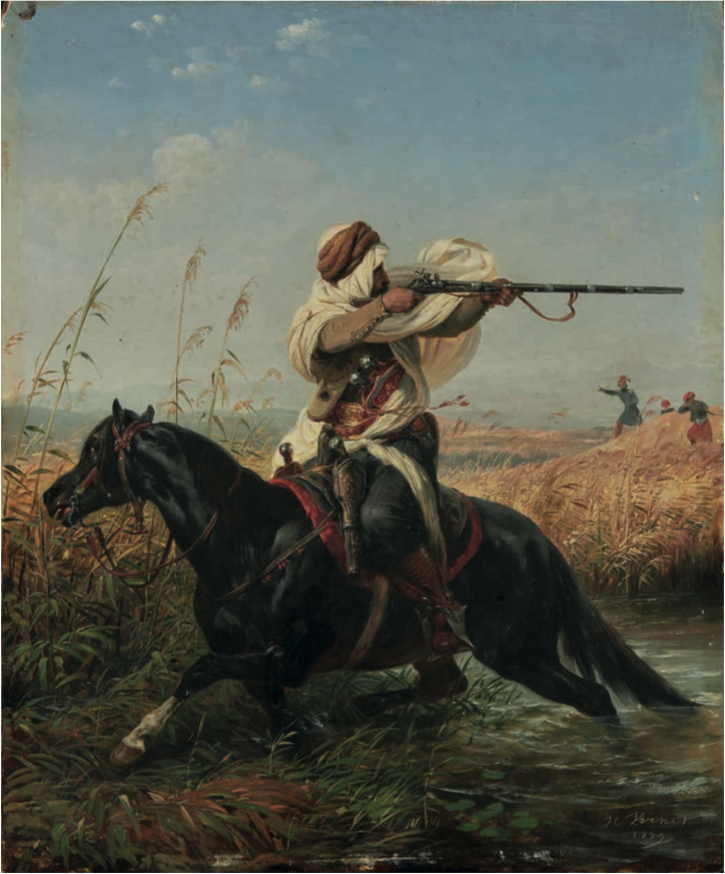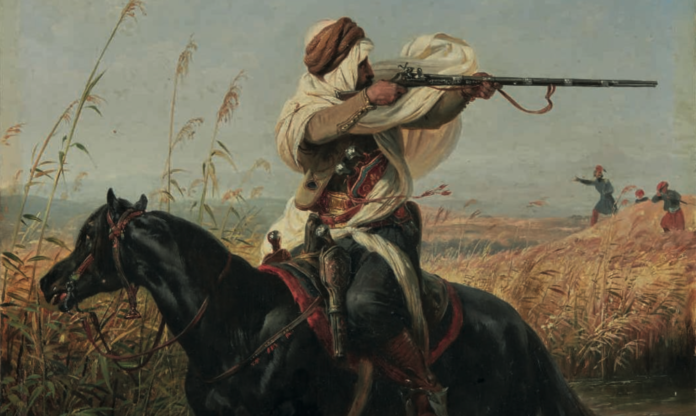In this ongoing series for Fine Art Today, we take a longer look at the history and features of a soon-to-be-available artwork of note. This week we highlight a magnificent tableaux by a 19th-century French painter regarded as the master of battles.
On Tuesday, September 19 in Paris, France, Christie’s will open a stunning auction of Tableaux pictures circa 1400-1900. Among the highlights of the sale is a stunning portrayal of an oriental soldier on horseback by 19th-century Frenchman Horace Vernet (1789-1863) — considered by many of his contemporaries (and current historians) to be the greatest painter of military history of his generation.
According to the National Gallery of Art, Washington, Vernet was “predestined for art by family inheritance: the grandson of the engraver Jean Moreau le Jeune on his mother’s side and, on his father’s side, of Joseph Vernet, France’s foremost painter of land- and seascapes.” Indeed, from an early age, Horace displayed incredible natural gifts in art and was considered a prodigy, becoming a professional artist in his teens.

“In a series of battle scenes from the Revolutionary and Napoleonic Wars, [Vernet] gave a foretaste of what was to become his specialty,” the NGA continues. “The Revolution in July 1830, which raised Louis-Philippe, Vernet’s patron, to the throne, opened vast opportunities of official employment to him. The rapid flow of state commissions for battle pieces that now came his way taxed even his prodigious facility. Four very large canvases for the Galerie des Batailles at Versailles, shown at the Salon of 1836, were followed by a second series in 1841. Accepting his calling as that of a painter of modern national subjects, specifically of scenes of combat, Vernet conceived of his work as a form of eyewitness reportage that required observation at the actual theaters of war. In five long visits to North Africa (1833, 1837, 1839-1840, 1845, 1853), he gathered on-the-spot documentation of the French conquests in Algiers and Morocco, material that he later worked up into wall-size canvases destined for Versailles. Louis-Philippe’s overthrow by the Revolution of 1848 and the advent of Napoleon III in 1849 scarcely affected his activity. The year 1850 found him at the French siege of Rome; in 1854, he visited the battlefields of the Crimea. He had in the meantime enjoyed the lucrative patronage of Czar Nicholas I during two long visits to Russia in 1836 and 1842-1843.”
Highlighting the September 19 auction at Christie’s is a beautiful work from France’s campaign to annex Algeria between 1830 and 1834. Completed in 1839, the work — titled “Arab Rider [La Retraite]” — was inspired by Vernet’s official visit to Algeria in 1833 as official painter to Louis-Philippe. Although many of France’s artists, such as Eugene Delacroix, were fascinated by the exploits of the French Army, Vernet was equally inspired by the oriental fighters, as evidenced by this Arab cavalier.
According to Christie’s, “Arab Rider” is a small but “monumental” painting. “Vernet’s excellence is represented by the picturesque details, which he carefully captures with care and accuracy. The shining coat of the thoroughbred, brilliant leatherwork, and dynamic character of the composition make this work a real jewel.”
Auction estimates are between $82,000 and $120,000. To learn more, visit Christie’s.
This article was featured in Fine Art Today, a weekly e-newsletter from Fine Art Connoisseur magazine. To start receiving Fine Art Today for free, click here.








